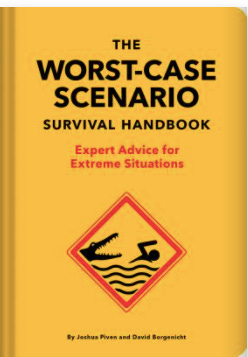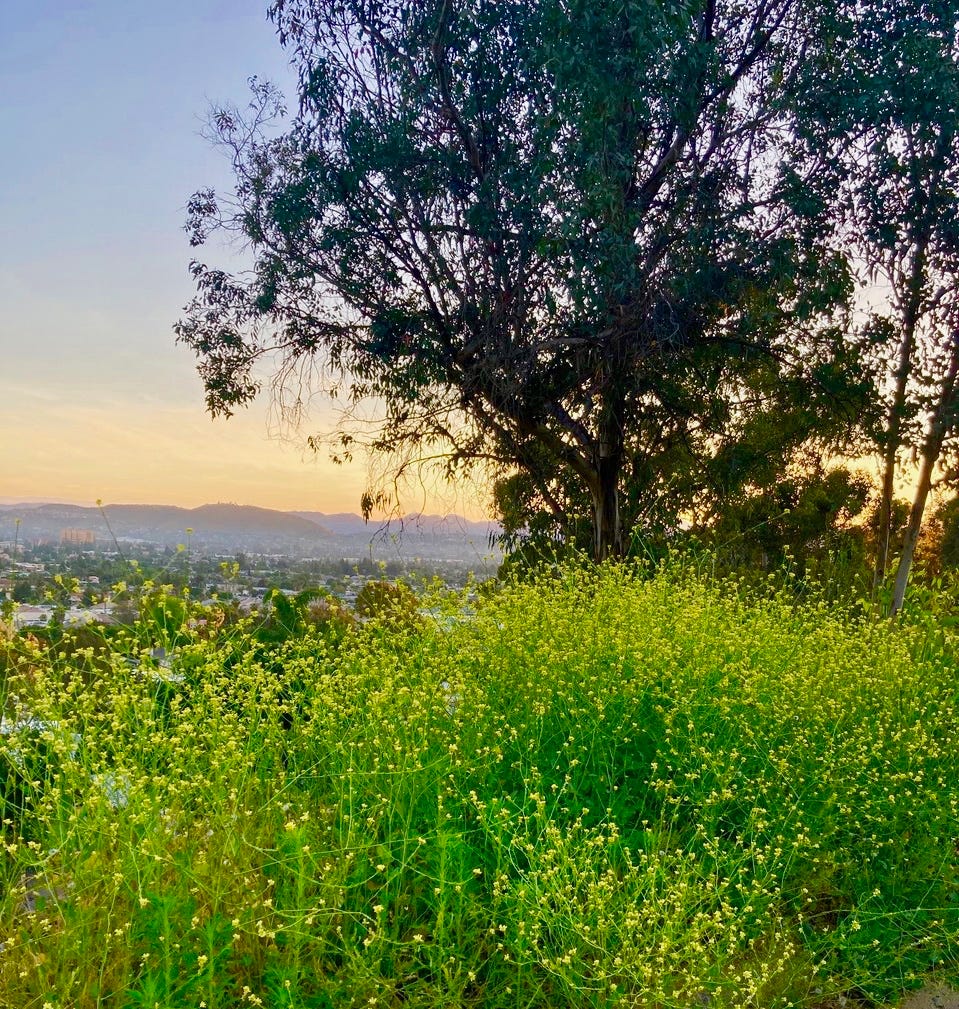How to wrestle free from an alligator
Or how a little yellow book made me feel better about everything
“No. I can survive well enough on my own— if given the proper reading material.”
― Sarah J. Maas, “Throne of Glass”
In this issue:
Surviving can be fun if you are just reading about it
Voting has begun! Here’s a shareable link for helping you and those you love make your voices heard and protect your vote
Contributions wanted: share your moment of Zen
I was just about asleep the other night when my eyelids flew open. I’d been imagining getting in the car and taking off across the country to celebrate the end of 2020 or the pandemic or both. Then in one of those leaps only a trained psychologist could explain, I began to wonder what happened to my special tool designed to help me escape from a car after it pitched off a bridge into the deep. My dad’s wife gave it to me years ago after I told her that one of my biggest fears in life was to be trapped in a sinking car. It had a little blade that popped out one end to cut the seatbelt. One corner was a kind of hammer meant to shatter the window.
More bad news: I’d not only lost the tool but I’d somehow lost my 20-year-old copy of the “Worst Case Scenario Survival Handbook” by Joshua Piven and David Borgenicht and lying there in the middle of the night, I felt bereft.

I ordered it the next day and instantly felt a little better about things. Since then, I’ve read it all the way through and now I recommend this little goldmine of information and unexpected humor as the perfect antidote for despair. Don’t know how to cope with one more headline? Take a break, read about the right way to jump from a building into a dumpster.
“The Dumpster may be filled with bricks or other unfriendly materials. It is entirely possible to survive a high fall (five stories or more) into a Dumpster, provided it is filled with the right type of trash (cardboard boxes are best) and you land correctly.” - How To Jump From a Building Into A Dumpster from “The Worst Case Scenario Handbook”
Or consider your response to a colony of killer bees and remember rule number one:
“Run away; swatting at the bees only makes them angrier.” - How to Escape Killer Bees from “The Worst Case Scenario Handbook”
This book is filled with pithy little statements like this. No chapter is over a hundred or so words. The authors keep things very simple. Very direct. Although sometimes, they do seem to leave out some important details. For example, in How to Survive if Your Parachute Fails to Open, success appears to depend entirely on the proximity of your nearest companion whose chute, presumably, has opened. If you are on your own, well, they don’t say much about that. Then there is this helpful tip when trying wrestle free from an alligator:
“Cover the alligator’s eyes. This will usually make it more sedate.” From How To Wrestle Free From An Alligator in “The Worst Case Scenario Handbook”

There are helpful diagrams but on the whole, it’s as if the authors fear overloading the reader with information or alternative scenarios thus raising her hopes that she might actually be able to do some of the things they describe: fend off a shark, escape quicksand or a python or both, land a plane, or deliver a baby in a taxi cab. I imagine the same technique would work on other types of vehicles as well but they are not mentioned.
“Try to control the python’s head and try to unwrap the coils starting from whichever end is available.” - From How to Escape From A Python in “The Worst Case Scenario Handbook”
The most important three pages and the reason I bought the book years ago in the first place come in the chapter How To Escape a Sinking Car. Here, we learn that there is no need to panic -- one has at least 30 to 60 seconds to escape. What a relief! If the windows are open, then it is a question of unhooking your seatbelt, holding your breath, and swimming through the window and up to the surface which is easily identified because the air bubbles escaping from the car and possibly from your mouth will head in that direction. If the windows and doors are closed, one must open or shatter the window as soon as possible with your foot, elbow, or some kind of tool, and get out. If the car sinks quickly and for some reason you are unable to break the window, you just sit calmly while the car fills with water and the pressure inside and outside the car is equalized. Then, hold your breath, push open the door, and up you go. Easy peasy, right?
This information led me once to insist that my husband as we crossed the Oakland Bay Bridge in a taxi that we lower windows before we crossed. This is because the car had electric windows which might not function after the car was submerged. I ignored him when he pointed out we were over 500 feet above the water and the impact alone might kill us. That’s the sort of detail the book glosses right over.
When I’m feeling anxious or afraid, I imagine worst-case scenarios. I turn into an information sponge. I achieve mastery over a situation by trying to know everything about it, imagining all the possible outcomes, and just generally making those I love very nervous and myself miserable. I’ve been doing a fair amount of that these past months, monitoring the news and seeking out information about things I can do nothing to control, as if knowing more will keep me safer or make it end sooner. This book was great to come upon again after all these years. It feeds my need to know while reminding me that too much information isn’t going to help much anyway. And when things get really crazy around me and my worst-case scenarios get more dire, I’ll reach for this and picture myself doing something a lot more fun, like putting a blindfold on an alligator.
Here’s a fun look at the latest updates to the “Worst Case Scenario Handbook” by Joshua Piven and .
Short Read
Here’s a short list of strategies for surviving everything from shark attacks to mothers-in-law. From the Readers Digest of course.
Listen to First-Hand Accounts
How I Survived, a podcast filled with first-person stories by those who survived everything from being trapped in the desert to being caught in an erupting volcano. are they true? They swear they are. I mean would Joe lie about waking up without a penis? You can see a list of episodes here. They range from 19 to 45 minutes in length.
Long Reads
Google books about survival and you will be overwhelmed. Clearly it is one of those enduring topics that will always have a hold on us whether we are preppers (for the very serious survivalists) or just folks who want to know how to survive 24 hours with a difficult mother-in-law.
A better escape, though, is to vicariously experience what it takes to survive against the odds and for that there is no better book than “Endurance: Shackleton’s Incredible Voyage” by Alfred Lansing. the story of Ernest Shackleton’s second failed attempt to reach the South Pole. The book is written like a novel. I listened to most of it on the StairMaster at the gym a long time ago and remember staying on the machine much longer than I would have just to hear what happened next. It’s got everything: long grueling Antarctic ice, boats crushed and abandoned, long trips by foot over the expanse, a crew left behind, a rescue, lots of descriptions and journal entries describing snow blindness, hunger, frostbite, pain but also the creative and resourceful ways that the men found to keep themselves going. Part of me was filled with admiration. Another part of me thought Shackleton was one of the most selfish people on earth. There is a difference between doing what must be done to live normally and choosing to expose one’s self and others to danger. Still, maybe we need those selfish people who push their boundaries in order to expand ours.
Calling for Your Contribution to “Moment of Zen”
Here’s your chance to share your “moment of Zen” that ends every issue of Spark. It’s going down as one of the most fun things ever. This week’s moment comes from
Sparker Sandra DeHelen.
What is YOUR moment of Zen? Let’s open this thing up. Send me your photos, a video, a drawing, a song, a poem, or anything with a visual that moved you, thrilled you, calmed you. Or just cracked you up. This feature is wide open for your own personal interpretation.
Come on, go through your photos, your memories or just keep your eyes and ears to the ground and then share. Send your photos/links, etc. to me by replying to this email or simply by sending to: elizabethmarro@substack.com. The main guidelines are probably already obvious: don’t hurt anyone -- don’t send anything that violates the privacy of someone you love or even someone you hate, don’t send anything divisive, or aimed at disparaging others. Our Zen moments are to help us connect, to bond, to learn, to wonder, to share -- to escape the world for a little bit and return refreshed.
I can’t wait to see what you send!
That’s it for this week. Both books mentioned in this issue are available from the Spark Community Recommendations page on Bookshop.org where every sale helps local bookstores and will, eventually, help us to raise money for literacy programs. In fact, if you have friends who have not heard of or are thinking about buying a book, send them over to our page to browse. And let me know what you are reading so we can expand our list! To comment, you may have to register first so to do that, just hit the subscribe button below and follow instructions and you’re good to go.
Gratefully yours,
Betsy
P.S. And now, your moment of Zen from El Cajon, CA where Sandra DeHelen saw the magic in a patch of black mustard with the city beyond




